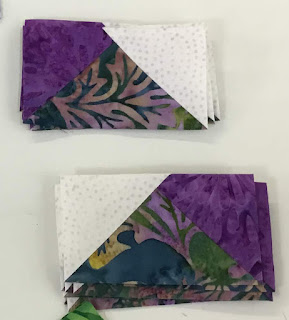The Wedge Star™ Tool was designed to make traditional Kaleidoscope Blocks. You can make 22 different sizes, ranging from 3" finished to 24" finished. The Instructions comes with instructions on how to make three basic blocks.
Using the tool is very easy to cut out your wedge and Diamond Shapes. I like to use paper plates to organize my pieces and fabrics for my projects.
Once you have all your diamonds and small wedges cut out it is highly recommended to lay out your pieces so you can easily access them and keep organized as you piece the diamond and wedge shapes together.
Not only is the tool used for cutting out your shapes. It is also used for trimming down your oversized pieces. The process is very similar to your Rapid Fire® Lemoyne Star pieces.
Another block you can make is the Mixed Block Wedge Block where you sew Large Wedges and Diamond Wedges together. You finish up the block with adding triangles around the corners and trimming to size using your Tucker Trimmer® III Tool.
The Wedge Star™ Tool is a fun tool to use, and I love making the blocks with the great Island Batik Basic Fabrics. I hope you will give it a try sometime, you can purchase the tool from your local quilt shop or visit the Studio 180 Design website. I should note when making the projects that I use Auriful 50wt thread. I finished my quilt using Hobbs Heirloom Natural Cotton Batting.
Now it is time to start thinking about my next Island Batik Project for the July. Also, be sure to check out the other Island Batik Ambassador blogs list below.
Carolina Asmussen ~Carolina Asmussen
Gene Black ~ Gene Black
Pamela Boatright ~ PamelaQuilts
Connie K Campbell ~ Freemotion by the River
Anja Clyke ~ Anja Quilts
Tina Dillard ~ Quilting Affection Designs
Becca Fenstermaker ~Pretty Piney
Jennifer Fulton ~ Inquiring Quilter
Barbara Gaddy ~ Bejeweled Quilts by Barb
Dione Gardner-Stephen ~ Clever Chameleon
Sarah Goer ~ Sarah Goer Quilts
Vasudha Govindan ~ Storied Quilts
Lori Haase ~ Dakota City Quilter II
Joanne Hart ~ Unicornharts
Mania (Magdalini) Hatziioannidi ~ Mania for Quilts
Carla Henton ~ Creatin in the Sticks
Stephanie Jacobson ~ Steph Jacobson Designs
Connie Kauffman ~ Kauffman Designs
Joan Kawano ~ Moosestash Quilting
Kim Lapacek ~ Persimon Dreams
Emily Leachman ~ The Darling Dogwood
Leanne Parsons ~ Devoted Quilter
Bea Lee ~ BeaQuilter
Toby Lischko ~ Gateway Quilts & Stuff
Bill Locke ~ Studio Bill Locke
Denise Looney ~ For the Love of Geese
Leah Malasky ~ Quilted Delights
Sally Manke ~ Sally Manke
Maryellen McAuliffe ~ Mary Mack's Blog
Kathleen McCormick ~ Kathleen McMusing
Carol Moellers ~ Carol Moellers Designs
Karen Neary ~ Sew Karen-ly Created
Lisa Nielsen ~ Lisa Lisa and the Quilt Jam
Jackie O’Brien ~ If These Threads Could Talk
Laura Piland ~ Slice of Pi Quilts
Michelle Roberts ~ Creative Blonde
Vicki Schlimmer ~ Vicki's Crafts and Quilting
Gail Sheppard ~ Quilting Gail
Sherry Shish ~ Powered by Quilting
Anita Skjellanger ~ Quilt in a not-Shell
Laticia "Tish" Stemple ~ Tish's Adventures in Wonderland
Jennifer Strauser ~ Dizzy Quilter
Jennifer Thomas ~ Curlicue Creations
Terri Vanden Bosch ~ Lizard Creek Quilts
Alison Vermilya ~ Little Bunny Quilts
Sandra Walker ~ mmm! quilts
Suzy Webster ~ Adventurous Applique and Quilting
(Debora) Anne Wiens ~ Seams like a Plan
Geraldine Wilkins ~ Living Water Quilter
Janet Yamamoto ~ Whispers of Yore
See you next month,
Tina
"Designs to Inspire"





























































